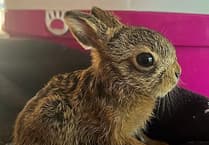In this week’s ManxSPCA column, general manager Juana Warburton delves into the fascinating history of one of the most iconic symbols of the Isle of Man’s - the Manx cat.
To mark Tynwald Day it seems appropriate to feature of one of our national symbols – namely, the Manx cat.
Cats are not native to the Isle of Man.
No-one knows when they were first introduced, but the Vikings probably played a large part in increasing the island’s feline population.
The Vikings liked cats and would give them as presents and, according to Norse legends, Freyja (the goddess of love) rode in a chariot pulled by two wild cats.
The breed that was probably most familiar to the Vikings was the ‘Norsk Skogkatt’, or Norwegian Forest cat, which had hind legs longer than its forelegs, as do Manx cats.
Both breeds also have double coats (a soft undercoat of thick, short hairs overlaid with coarser, longer hair), share a liking for water, and tend not to be very vocal.
The first references to Manx cats being tailless occurred in the early eighteenth century. ‘Cat’ in Manx is ‘kayt’ and all cats on the island appeared to have been referred to as such until around 1750 when a new word ‘stubbin’ crept into Manx from the English ‘stubby’. ‘Stubbin’ in Manx is a cat with no tail or only a short stump, and so it seems likely that tailless cats became common enough at this time for people to need a word to distinguish them from their tailed cousins.
The shortening of the tail in Manx cats appears to have arisen spontaneously and to be the result of what is known in genetics as the ‘founder effect’, where distinctive differences arise from a limited gene pool. If there is little variation in the gene pool then the differences can become fixed, and as the gene pool of cats on the Isle of Man was relatively small, short tails (or no tails) became much more common as a result of inbreeding. Inbreeding was, of course, part and parcel of being on an island.
The Manx cat was seen as a welcome addition to most farms because of their excellence as hunters, and they were often kept as working animals and used as rodent control. Before the days of neutering, colonies of feral Manx cats thrived such as the one at the Douglas horse tram stables that established itself in the 1950s. Cats from this colony were regularly observed tackling herring gulls, assisted by their longer back legs which enabled them to jump to catch their prey.
.jpg?width=752&height=500&crop=752:500)
Apart from their hunting ability, Manx cats were particularly popular ships’ cats because a common naval belief was that a cat could bring on a storm using magic stored in its tail. And if you don’t have a tail you can’t start a storm! In 1963 a tabby Manx cat was presented to the Queen Mother when she visited Castletown, and this cat then became the ship’s cat on the royal yacht Britannia. He was called ‘Schickrys’ which is Manx for ‘certain’.
To maintain a supply of Manx cats the Isle of Man Government set up a cattery at Knockaloe farm in 1961, but the farm was difficult for tourists to visit and so in 1964 the cattery moved to Nobles Park, where it stayed for the next thirty years.
The cattery closed in 1992 due to spiraling costs and concerns about cat welfare, but Manx cats are still prevalent on the island. We rehomed 20 last year, and although we don’t have any in our cattery at the moment we do have a cat with a very Manx name, Illiam, and no tail (although he isn’t technically a Manx cat).
Two-year-old Illiam came to us with an old injury to his tail, which meant that it had to be amputated.
He’s now fully recovered and looking to start a new life.
Illiam enjoys the outdoors, but equally he likes his home comforts and human company. He seems to like other cats and, given he’s quite a confident little cat, we think he could cope with a dog in his life too. If you would like to meet him, please contact [email protected].
.JPG?trim=0,0,0,0&width=752&height=499&crop=752:499)
.jpeg?width=209&height=140&crop=209:145,smart&quality=75)

.jpeg?width=209&height=140&crop=209:145,smart&quality=75)

Comments
This article has no comments yet. Be the first to leave a comment.